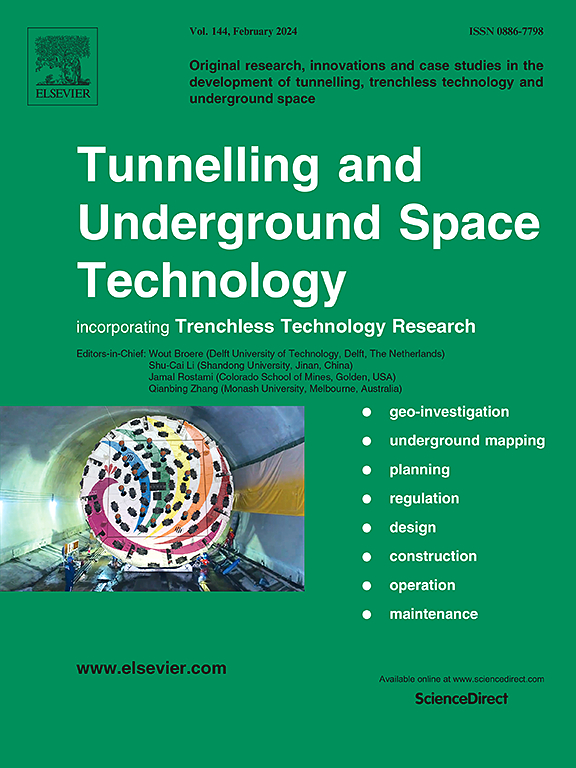考虑震源-构造地震输入和近断层效应的跨断层隧道动力响应分析
IF 6.7
1区 工程技术
Q1 CONSTRUCTION & BUILDING TECHNOLOGY
引用次数: 0
摘要
由于同震位错和复杂地震动波场的共同作用,穿越活动断层的隧道在近断层地震中容易受到严重破坏。为了捕捉近断层地震动的时空特征及其对隧道结构的影响,本研究提出了一个基于物理的源-结构模拟框架。采用频率-波数(F-K)积分方法,基于2022年门源Mw 6.6地震有限断层源模型,重建了0.1 ~ 10 Hz的宽带地震波场。将这些波形离散化,并应用于大梁隧道的非线性有限元模型,该隧道在地震中遭受了严重的破坏。模拟位移时程与经典有限断层解吻合较好,同震位移的空间分布与InSAR观测值吻合较好,特别是在振幅和趋势上。在震中50 km范围内,模拟的峰值地面加速度(PGAs)与强震记录吻合较好,1 Hz以下的傅立叶谱与观测数据吻合较好。通过分析走向和法向的PGV/PGA比值,捕获了定向速度脉冲和飞阶效应,并通过小波变换分析近断层站响应进行了进一步证实。构造分析表明,断层穿越段经历了以位错为主的准静态剪切,而远离断层的段主要受定向速度脉冲的影响。这些脉冲引起的动应力占准静态应力的57.1%。研究结果强调了低频地震动分量和方向效应在评估跨断层隧道的地震反应和破坏机制中的重要性。本文章由计算机程序翻译,如有差异,请以英文原文为准。
Dynamic response analysis of cross-fault tunnel considering source-to-structure seismic input and near-fault effect
Tunnels crossing active faults are vulnerable to severe damage under near-fault earthquakes due to the combined effects of co-seismic dislocation and complex ground motion wavefields. To capture the spatiotemporal features of near-fault ground motion and their effects on tunnel structures, this study proposes a physics-based source-to-structure simulation framework. A frequency-wavenumber (F-K) integration method is used to reconstruct broadband seismic wavefields (0.1–10 Hz) based on the finite-fault source model of the 2022 Mw 6.6 Menyuan earthquake. These waveforms are discretized and applied to a nonlinear finite element model of the Daliang Tunnel, which experienced severe damage during the event. The simulated displacement time histories match well with classical finite fault solutions, and the spatial distribution of co-seismic displacements shows good agreement with InSAR observations, especially in amplitude and trend. Within 50 km of the epicenter, the simulated peak ground accelerations (PGAs) agree closely with strong motion records, and the Fourier spectra below 1 Hz are consistent with observed data. Directional velocity pulses and fling-step effects are captured by analyzing PGV/PGA ratios in strike and normal directions, and further confirmed by wavelet transform analysis of near-fault station responses. Structural analysis reveals that fault-crossing segments experience quasi-static shearing dominated by dislocation, while segments farther from the fault are mainly affected by directional velocity pulses. The dynamic stress induced by these pulses accounts for up to 57.1 % of the quasi-static stress. The results highlight the critical importance of low-frequency ground motion components and directional effects in evaluating the seismic response and damage mechanisms of cross-fault tunnels.
求助全文
通过发布文献求助,成功后即可免费获取论文全文。
去求助
来源期刊

Tunnelling and Underground Space Technology
工程技术-工程:土木
CiteScore
11.90
自引率
18.80%
发文量
454
审稿时长
10.8 months
期刊介绍:
Tunnelling and Underground Space Technology is an international journal which publishes authoritative articles encompassing the development of innovative uses of underground space and the results of high quality research into improved, more cost-effective techniques for the planning, geo-investigation, design, construction, operation and maintenance of underground and earth-sheltered structures. The journal provides an effective vehicle for the improved worldwide exchange of information on developments in underground technology - and the experience gained from its use - and is strongly committed to publishing papers on the interdisciplinary aspects of creating, planning, and regulating underground space.
 求助内容:
求助内容: 应助结果提醒方式:
应助结果提醒方式:


